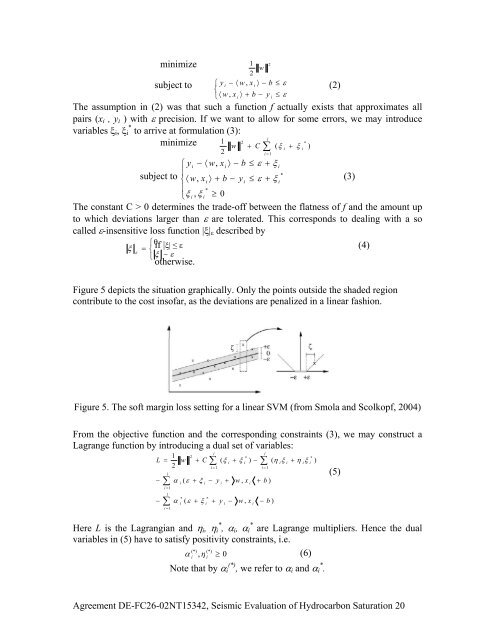Agreement DE-FC26-02NT15342, Seismic Evaluation of ...
Agreement DE-FC26-02NT15342, Seismic Evaluation of ...
Agreement DE-FC26-02NT15342, Seismic Evaluation of ...
Create successful ePaper yourself
Turn your PDF publications into a flip-book with our unique Google optimized e-Paper software.
minimize 1 w<br />
2<br />
2<br />
subject to y<br />
i<br />
− 〈 w x<br />
i<br />
〉 −<br />
⎧<br />
⎨<br />
⎩ 〈 w , x<br />
i<br />
b ≤ ε<br />
〉 + b − y ≤ ε<br />
, (2)<br />
The assumption in (2) was that such a function f actually exists that approximates all<br />
pairs (x i , y i ) with ε precision. If we want to allow for some errors, we may introduce<br />
variables ξ i , ξ * i to arrive at formulation (3):<br />
l<br />
minimize 1 2<br />
*<br />
w + C ∑ ( ξ<br />
i<br />
+ ξ<br />
i<br />
)<br />
2<br />
i = 1<br />
⎧ y<br />
i<br />
− 〈 w,<br />
x<br />
i<br />
〉 − b ≤ ε + ξ<br />
i<br />
subject to<br />
⎪<br />
*<br />
⎨〈<br />
w,<br />
x<br />
i<br />
〉 + b − y<br />
i<br />
≤ ε + ξ<br />
(3)<br />
i<br />
⎪ *<br />
⎩ξ<br />
i<br />
, ξ<br />
i<br />
≥ 0<br />
The constant C > 0 determines the trade-<strong>of</strong>f between the flatness <strong>of</strong> f and the amount up<br />
to which deviations larger than ε are tolerated. This corresponds to dealing with a so<br />
called ε-insensitive loss function |ξ| ε described by<br />
⎧<br />
= if |ξ| ≤ ε<br />
⎨<br />
⎩ ξ − ε<br />
ξ ε<br />
0 (4)<br />
otherwise.<br />
i<br />
Figure 5 depicts the situation graphically. Only the points outside the shaded region<br />
contribute to the cost ins<strong>of</strong>ar, as the deviations are penalized in a linear fashion.<br />
Figure 5. The s<strong>of</strong>t margin loss setting for a linear SVM (from Smola and Scolkopf, 2004)<br />
From the objective function and the corresponding constraints (3), we may construct a<br />
Lagrange function by introducing a dual set <strong>of</strong> variables:<br />
L =<br />
−<br />
−<br />
l<br />
∑<br />
i = 1<br />
l<br />
∑<br />
i = 1<br />
1<br />
2<br />
w<br />
*<br />
i<br />
2<br />
+ C<br />
*<br />
i<br />
i = 1<br />
α ( ε + ξ − y<br />
i<br />
α ( ε + ξ +<br />
i<br />
l<br />
∑<br />
*<br />
( ξ + ξ ) −<br />
i<br />
y<br />
i<br />
i<br />
+<br />
−<br />
i<br />
w , x<br />
i<br />
w , x<br />
i<br />
l<br />
∑<br />
i = 1<br />
+ b )<br />
− b )<br />
*<br />
( η ξ + η ξ )<br />
Here L is the Lagrangian and η i , η * i , α i , α * i are Lagrange multipliers. Hence the dual<br />
variables in (5) have to satisfy positivity constraints, i.e.<br />
α (*) (*)<br />
i<br />
,η i<br />
≥ 0 (6)<br />
Note that by α i (*) , we refer to α i and α i * .<br />
i<br />
i<br />
i<br />
i<br />
(5)<br />
<strong>Agreement</strong> <strong>DE</strong>-<strong>FC26</strong>-<strong>02NT15342</strong>, <strong>Seismic</strong> <strong>Evaluation</strong> <strong>of</strong> Hydrocarbon Saturation 20
















